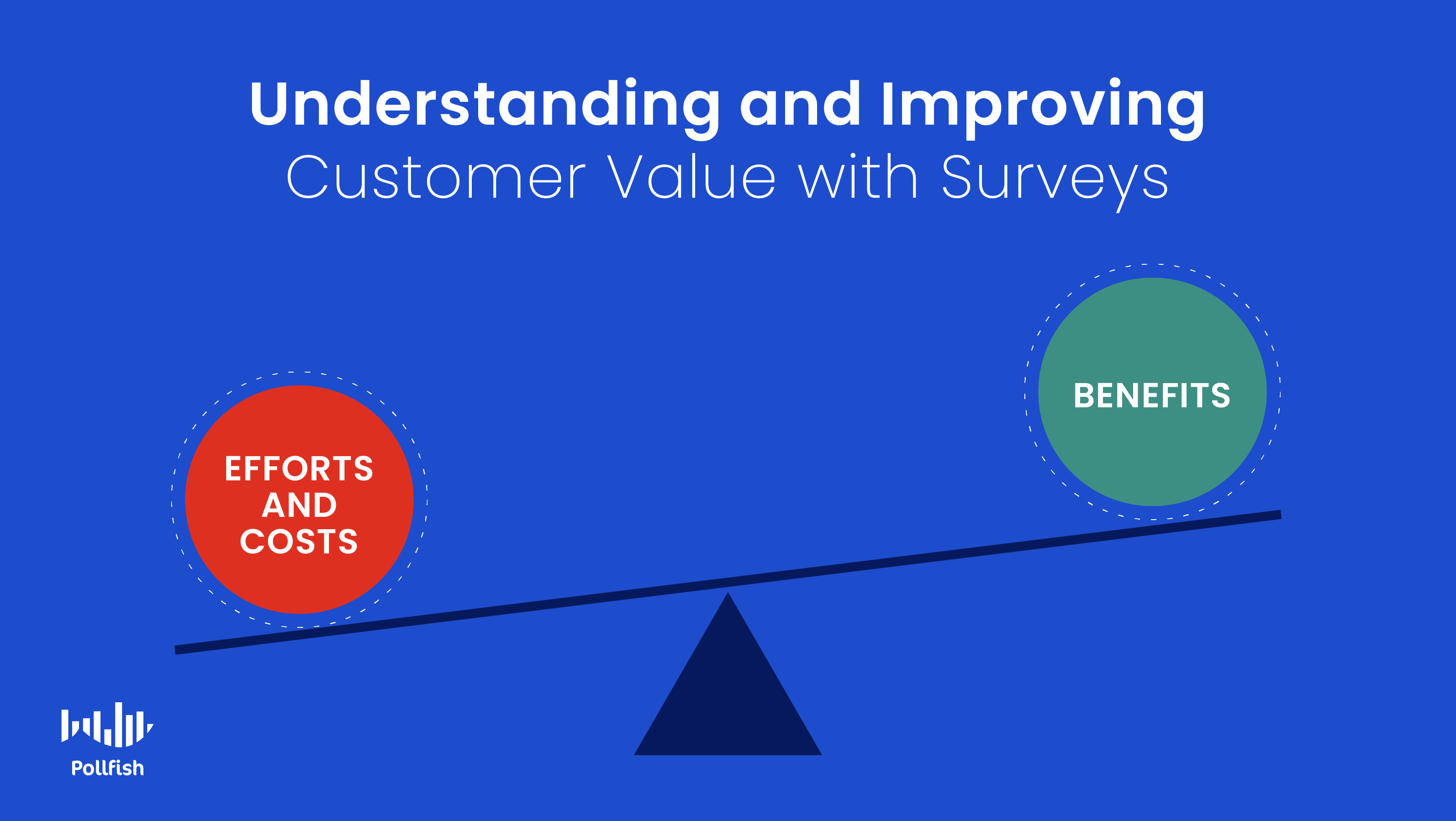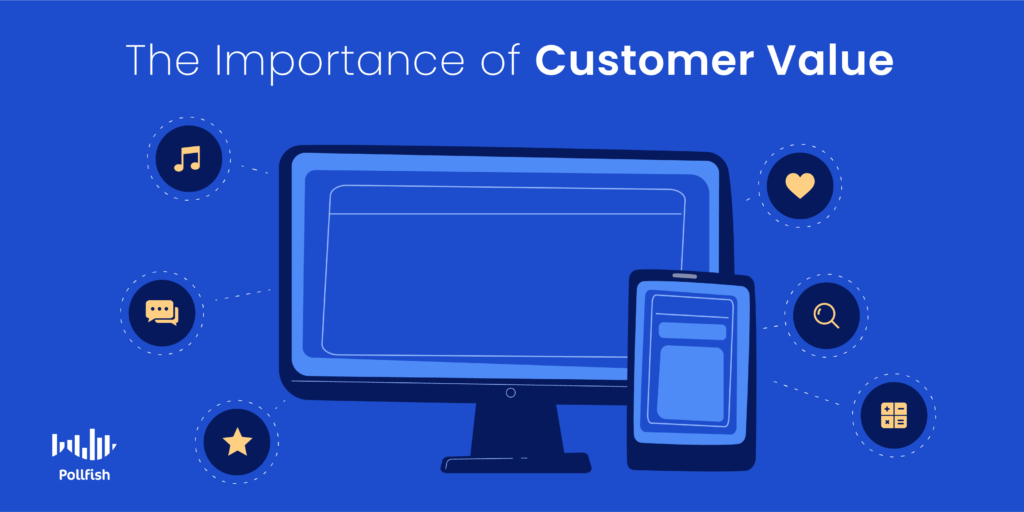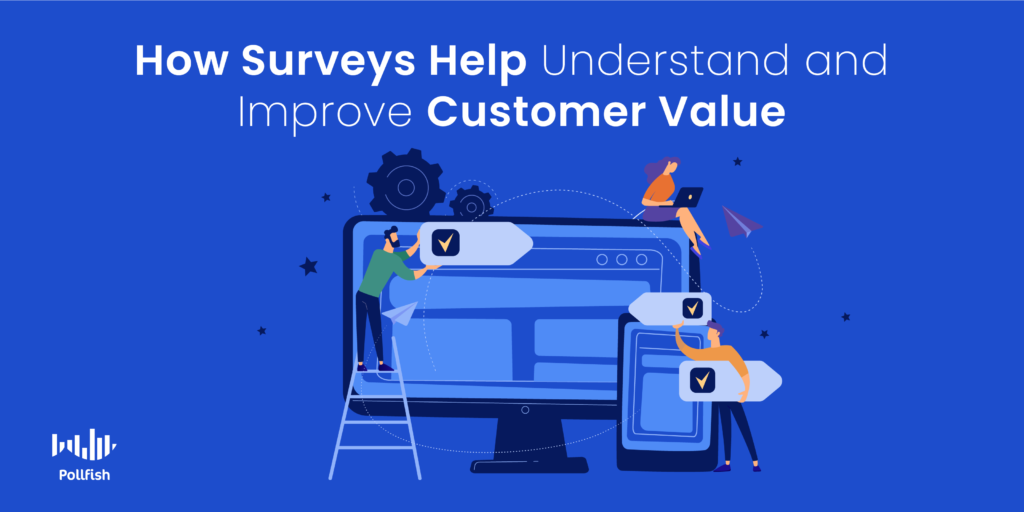Understanding Customer Value and How Businesses Can Generate It with Surveys

Customer value is a key aspect for acquiring, developing and retaining customers. Businesses would be remiss not to work on improving it to sustain profitable customer relationships.
Contrary to its name, it does not signify the value that a customer brings to a business — which is not to say that customers don’t carry value. Rather, customer value denotes the satisfaction a customer experiences or expects to experience by taking an action relative to the cost of that action.
Businesses must provide this value, as over 65% of customers globally believe it is very important for businesses to understand their unique needs and expectations. When a business properly serves its target market, then its members derive a higher customer value.
In turn, this makes a business more competitive and better positioned to develop customer satisfaction and build customer loyalty.
This article explains the concept of customer value, its importance, how to calculate it, how surveys can improve it and more.
Understanding Customer Value
Also called customer-perceived value, this concept is defined by the perception of what a product or service is worth to a customer versus its possible alternatives.
More specifically, it entails the benefits a customer derives from a service or product in relation to the customer’s costs, which include all the efforts and difficulties they face when obtaining or using a product or service.
In short, this measurement explains whether a customer feels they received benefits over the price that they paid.
In this regard, “paying” does not simply refer to prices such as one-time and subscription costs, fees, interest, etc. Instead, it also includes non-price aspects, such as providing their effort, energy, time, data and other inconveniences.
In addition, payments do not necessarily refer to purchases; they can also mean store visits, sign-ups, content downloads and more.
The benefits in customer value denote the advantages or quality of a product, service, image and the brand equity of a company, along with a good customer experience (CX), values, the success a customer experiences from using a product and so on.
Businesses can heighten their customer value when they augment their core competencies and other drivers of value to better serve all customers’ needs and concerns.
The Importance of Customer Value

Customer value is important for businesses for many reasons.
Firstly, customer value increases both the customer experience and customer satisfaction. CX plays a major role in the long-term success of brands, as 74% of customers are likely to buy based on customer experience alone. Experience-driven businesses also see a 1.5 times higher YoY growth in repeat purchases and customer retention, a necessity for maintaining a business’s customer base.
The reverse also occurs, as a good customer experience creates customer value.
As for customer satisfaction, it is especially important for a business, as unhappy customers churn, while satisfied customers stay and are far more likely to become repeat customers. Thus, satisfaction drives loyalty, thereby upholding customer retention. Customer value is largely involved with satisfaction, as satisfied customers drive some sort of value, while dissatisfied customers either don’t or gain very little from their transactions and engagements with a business.
Customer value also forges customer advocacy, in which the customers themselves act as marketers for a company. Customer advocates recommend the companies that bring them value, thereby spreading brand awareness, fostering a positive brand image and essentially providing free marketing services. Customer advocates spread their messages across social media, review websites, forums, blogs (if they have them) and also produce word-of-mouth marketing. This can attract many new leads and conversions.
Additionally, customer value steers sales forward, as it creates a sense of urgency for customers, prompting them to not simply buy but to buy sooner. By forming timeframes for key value-building benefits to the customers, such as increased efficiency, lower downtime, better quality, and many more value points, customers will be much more drawn to purchase from a business in a timely manner. In turn, sales workers can close sales quicker.
Finally, while it may seem to be a stretch, creating customer value contributes to a business’s market share — the percentage of a total market a business controls for its products and services. A higher market share allows businesses to operate on a greater scale and increase their profitability. This occurs when businesses provide as much customer value as possible, such as pricing convenience, useful products and many other factors.
How to Calculate Customer Value
Although customer value includes intangible items in addition to tangible ones, businesses can still measure it to understand the value their customers derive from their business. First, businesses must consider all the factors that make up the two main variables in customer value: benefits and costs.
When compiling all of these factors, businesses must identify the most relevant ones in relation to their business and for their customers. The reason behind this is evident, given that businesses have different value propositions, offerings, prices and so on.
Although the calculation for customer value is simple, the many factors behind its two variables render this calculation more of a rough estimate, than a hard and fast metric.
The following lays out the various components of customer benefits and costs:
Total Customer Benefits:
- Product benefit
- the problem a product solves
- ease of onboarding
- Service benefit
- service convenience
- Experience benefit
- ease of use
- Personal benefit
- social status
- Image/branding benefit
- brand reputation
Total Customer Costs:
- Monetary costs
- Tangible
- The price of a product or service
- Installation or onboarding costs
- Renewal costs
- Tangible
- Time costs
- Intangible
- Time invested in buying a product or service
- Time invested in learning how to use a product
- Intangible
- Energy costs
- Tangible
- Installation or onboarding costs
- Maintenance costs
- The cost of accessing your product or service
- Renewal costs
- Intangible
- Time spent understanding how your product or service works
- Physical commitment
- Tangible
- Psychic/emotional costs
- Tangible
- The cost of accessing your product or service
- The cost of using a service/product with issues
- Intangible
- A poor customer experience
- Physical or emotional stress induced from buying or installing your product
- A poor brand reputation
- Tangible
Businesses must bear in mind that because this calculation includes tangible and intangible elements, the customer value formula won’t look like a typical mathematic calculation.
You’ll need to specify how much benefits are worth in comparison to the costs customers incur, such as time investment, emotional stress, and more.
Customer value is also going to vary depending on the customer segments you analyze. Since each segment, customer persona and individual customer is different, they’ll have particular needs, expectations and goals.
As such, they’ll have customer values, along with different standards of good and poor value. Businesses should therefore conduct market segmentation, identify personas and calculate the customer value for each segment and persona.
The Customer Value Formula
After you consider all the possible benefits and costs associated with your business or particular product or service, and have narrowed down the most relevant, you’ll need to plug them into the customer value formula.
Use the following formula:
(Total Customer Benefits – Total Customer Costs) = Customer Value
(B – C = CV)
How Surveys Help Improve Customer Value

Online surveys provide a method that goes far beyond understanding a target market, or any group of customers. It can significantly improve customer value. Here’s why:
Brands should consider that when they sell a product, the utility of that product usually doesn’t change among customers. However, although its functionality remains the same, customer value will waver, as customers find value in different aspects of a product.
Surveys give businesses a firsthand approach of understanding what they consider valuable and what tarnishes that value for them. Adding to this, surveys can be set up in a number of ways, allowing business to both measure and gain specific customer data.
With online surveys, businesses can segment their customers and identify personas, as surveys are potent tools for market segmentation. In addition, online surveys grant businesses the ability to target their most loyal customer group.
Thus, surveying allows them to understand the makeup of their target market more precisely and study the most valuable subsets of customers.
There are also numerous kinds of customer satisfaction surveys, such as the net promoter score, or NPS survey and the customer effort score, or CES survey. The CES survey is particularly relevant to customer value, as it measures customer effort, one of the costs and variables of customer value.
Businesses should also consider that customer needs change throughout the customer journey and especially during a customer lifecycle. The customer journey includes pre-sales purchase intent, the browsing, the actual purchase, the installation, the use of a product or service and post-sales events. Thus, what they prioritize in terms of value is constantly changing.
Surveys allow companies to keep track of those changes, whether it is via brand tracking, brand visibility, changes in customer loyalty and more. Surveys can be deployed through various stages in the sales process making it easy to detect changes and consistencies in what customers perceive to be valuable about a business and its offerings.
Additionally, surveys allow businesses to evaluate how different customer segments feel about their pricing in a simple way. This is important to customer value, given that price is one of the major costs associated with customer value and a general customer pain point. All answers remain anonymous, which allows customers to be honest about how they feel about prices.
Forging Value Across All Offerings
In summary, businesses ought to pay careful attention to their customer value, as it dictates how customers perceive a brand in terms of its value to them. It is evident that businesses with low customer value will inevitably lose customers, while those with high customer value will retain and acquire customers.
Online surveys provide a quick and efficient way for businesses to understand and improve their customer value, as surveys gain insights on all the factors and variables of this notion. They can show where businesses are lacking, how they can improve and most importantly, what it is specifically that customers want and need.
However, not all online survey platforms offer the same functionalities and efficiencies. Businesses must therefore invest in a strong online survey platform, one that makes it easy to create and deploy surveys.
Additionally, they should opt for providers that offer high-quality data, such as RDE (random device engagement sampling) to net respondents in their natural digital habitats in a completely randomized way, as well as include artificial intelligence that performs quality checks that ensure the highest quality of customer data.
When an online survey provider offers all of these functionalities and customer service around the clock, businesses are poised to gain valuable insights on customer value, raise it and are generally in good hands for all other customer data needs.
Pollfish Marketing Team
Ready to Try Pollfish?
Create your survey with AI, target high-quality respondents starting at $0.95 per complete, and start getting results in just minutes in real-time. From running a simple product concept survey to managing a constant stream of trackers for dozens of clients in dozens of countries, we’ve got you.
